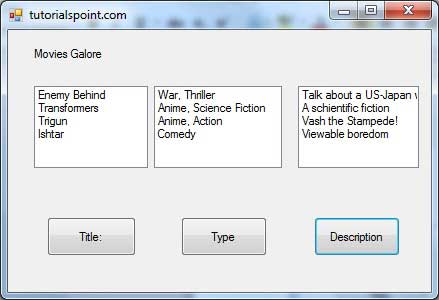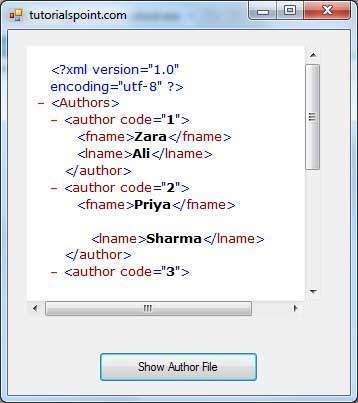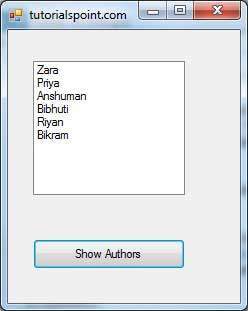
- VB.Net Basic Tutorial
- VB.Net - Home
- VB.Net - Overview
- VB.Net - Environment Setup
- VB.Net - Program Structure
- VB.Net - Basic Syntax
- VB.Net - Data Types
- VB.Net - Variables
- VB.Net - Constants
- VB.Net - Modifiers
- VB.Net - Statements
- VB.Net - Directives
- VB.Net - Operators
- VB.Net - Decision Making
- VB.Net - Loops
- VB.Net - Strings
- VB.Net - Date & Time
- VB.Net - Arrays
- VB.Net - Collections
- VB.Net - Functions
- VB.Net - Subs
- VB.Net - Classes & Objects
- VB.Net - Exception Handling
- VB.Net - File Handling
- VB.Net - Basic Controls
- VB.Net - Dialog Boxes
- VB.Net - Advanced Forms
- VB.Net - Event Handling
- VB.Net Advanced Tutorial
- VB.Net - Regular Expressions
- VB.Net - Database Access
- VB.Net - Excel Sheet
- VB.Net - Send Email
- VB.Net - XML Processing
- VB.Net - Web Programming
- VB.Net Useful Resources
- VB.Net - Quick Guide
- VB.Net - Useful Resources
- VB.Net - Discussion
VB.Net - XML Processing
The Extensible Markup Language (XML) is a markup language much like HTML or SGML. This is recommended by the World Wide Web Consortium and available as an open standard.
The System.Xml namespace in the .Net Framework contains classes for processing XML documents. Following are some of the commonly used classes in the System.Xml namespace.
| Sr.No. | Class & Description |
|---|---|
| 1 |
XmlAttribute Represents an attribute. Valid and default values for the attribute are defined in a document type definition (DTD) or schema. |
| 2 | XmlCDataSection Represents a CDATA section. |
| 3 | XmlCharacterData Provides text manipulation methods that are used by several classes. |
| 4 | XmlComment Represents the content of an XML comment. |
| 5 | XmlConvert Encodes and decodes XML names and provides methods for converting between common language runtime types and XML Schema definition language (XSD) types. When converting data types, the values returned are locale independent. |
| 6 | XmlDeclaration Represents the XML declaration node <?xml version='1.0'...?>. |
| 7 | XmlDictionary Implements a dictionary used to optimize Windows Communication Foundation (WCF)'s XML reader/writer implementations. |
| 8 | XmlDictionaryReader An abstract class that the Windows Communication Foundation (WCF) derives from XmlReader to do serialization and deserialization. |
| 9 |
XmlDictionaryWriter Represents an abstract class that Windows Communication Foundation (WCF) derives from XmlWriter to do serialization and deserialization. |
| 10 | XmlDocument Represents an XML document. |
| 11 | XmlDocumentFragment Represents a lightweight object that is useful for tree insert operations. |
| 12 | XmlDocumentType Represents the document type declaration. |
| 13 | XmlElement Represents an element. |
| 14 | XmlEntity Represents an entity declaration, such as <!ENTITY... >. |
| 15 | XmlEntityReference Represents an entity reference node. |
| 16 | XmlException Returns detailed information about the last exception. |
| 17 | XmlImplementation Defines the context for a set of XmlDocument objects. |
| 18 | XmlLinkedNode Gets the node immediately preceding or following this node. |
| 19 | XmlNode Represents a single node in the XML document. |
| 20 | XmlNodeList Represents an ordered collection of nodes. |
| 21 | XmlNodeReader Represents a reader that provides fast, non-cached forward only access to XML data in an XmlNode. |
| 22 | XmlNotation Represents a notation declaration, such as <!NOTATION... >. |
| 23 | XmlParserContext Provides all the context information required by the XmlReader to parse an XML fragment. |
| 24 | XmlProcessingInstruction Represents a processing instruction, which XML defines to keep processor-specific information in the text of the document. |
| 25 | XmlQualifiedName Represents an XML qualified name. |
| 26 | XmlReader Represents a reader that provides fast, noncached, forward-only access to XML data. |
| 27 | XmlReaderSettings Specifies a set of features to support on the XmlReader object created by the Create method. |
| 28 | XmlResolver Resolves external XML resources named by a Uniform Resource Identifier (URI). |
| 29 | XmlSecureResolver Helps to secure another implementation of XmlResolver by wrapping the XmlResolver object and restricting the resources that the underlying XmlResolver has access to. |
| 30 | XmlSignificantWhitespace Represents white space between markup in a mixed content node or white space within an xml:space= 'preserve' scope. This is also referred to as significant white space. |
| 31 | XmlText Represents the text content of an element or attribute. |
| 32 | XmlTextReader Represents a reader that provides fast, non-cached, forward-only access to XML data. |
| 33 | XmlTextWriter Represents a writer that provides a fast, non-cached, forward-only way of generating streams or files containing XML data that conforms to the W3C Extensible Markup Language (XML) 1.0 and the Namespaces in XML recommendations. |
| 34 | XmlUrlResolver Resolves external XML resources named by a Uniform Resource Identifier (URI). |
| 35 | XmlWhitespace Represents white space in element content. |
| 36 | XmlWriter Represents a writer that provides a fast, non-cached, forward-only means of generating streams or files containing XML data. |
| 37 | XmlWriterSettings Specifies a set of features to support on the XmlWriter object created by the XmlWriter.Create method. |
XML Parser APIs
The two most basic and broadly used APIs to XML data are the SAX and DOM interfaces.
Simple API for XML (SAX) − Here, you register callbacks for events of interest and then let the parser proceed through the document. This is useful when your documents are large or you have memory limitations, it parses the file as it reads it from disk, and the entire file is never stored in memory.
Document Object Model (DOM) API − This is World Wide Web Consortium recommendation wherein the entire file is read into memory and stored in a hierarchical (tree-based) form to represent all the features of an XML document.
SAX obviously can't process information as fast as DOM can when working with large files. On the other hand, using DOM exclusively can really kill your resources, especially if used on a lot of small files.
SAX is read-only, while DOM allows changes to the XML file. Since these two different APIs literally complement each other there is no reason why you can't use them both for large projects.
For all our XML code examples, let's use a simple XML file movies.xml as an input −
<?xml version = "1.0"?>
<collection shelf = "New Arrivals">
<movie title = "Enemy Behind">
<type>War, Thriller</type>
<format>DVD</format>
<year>2003</year>
<rating>PG</rating>
<stars>10</stars>
<description>Talk about a US-Japan war</description>
</movie>
<movie title = "Transformers">
<type>Anime, Science Fiction</type>
<format>DVD</format>
<year>1989</year>
<rating>R</rating>
<stars>8</stars>
<description>A schientific fiction</description>
</movie>
<movie title = "Trigun">
<type>Anime, Action</type>
<format>DVD</format>
<episodes>4</episodes>
<rating>PG</rating>
<stars>10</stars>
<description>Vash the Stampede!</description>
</movie>
<movie title = "Ishtar">
<type>Comedy</type>
<format>VHS</format>
<rating>PG</rating>
<stars>2</stars>
<description>Viewable boredom</description>
</movie>
</collection>
Parsing XML with SAX API
In SAX model, you use the XmlReader and XmlWriter classes to work with the XML data.
The XmlReader class is used to read XML data in a fast, forward-only and non-cached manner. It reads an XML document or a stream.
Example 1
This example demonstrates reading XML data from the file movies.xml.
Take the following steps −
Add the movies.xml file in the bin\Debug folder of your application.
Import the System.Xml namespace in Form1.vb file.
Add a label in the form and change its text to 'Movies Galore'.
Add three list boxes and three buttons to show the title, type and description of a movie from the xml file.
Add the following code using the code editor window.
Imports System.Xml
Public Class Form1
Private Sub Form1_Load(sender As Object, e As EventArgs) Handles MyBase.Load
' Set the caption bar text of the form.
Me.Text = "tutorialspoint.com"
End Sub
Private Sub Button1_Click(sender As Object, e As EventArgs) Handles Button1.Click
ListBox1().Items.Clear()
Dim xr As XmlReader = XmlReader.Create("movies.xml")
Do While xr.Read()
If xr.NodeType = XmlNodeType.Element AndAlso xr.Name = "movie" Then
ListBox1.Items.Add(xr.GetAttribute(0))
End If
Loop
End Sub
Private Sub Button2_Click(sender As Object, e As EventArgs) Handles Button2.Click
ListBox2().Items.Clear()
Dim xr As XmlReader = XmlReader.Create("movies.xml")
Do While xr.Read()
If xr.NodeType = XmlNodeType.Element AndAlso xr.Name = "type" Then
ListBox2.Items.Add(xr.ReadElementString)
Else
xr.Read()
End If
Loop
End Sub
Private Sub Button3_Click(sender As Object, e As EventArgs) Handles Button3.Click
ListBox3().Items.Clear()
Dim xr As XmlReader = XmlReader.Create("movies.xml")
Do While xr.Read()
If xr.NodeType = XmlNodeType.Element AndAlso xr.Name = "description" Then
ListBox3.Items.Add(xr.ReadElementString)
Else
xr.Read()
End If
Loop
End Sub
End Class
Execute and run the above code using Start button available at the Microsoft Visual Studio tool bar. Clicking on the buttons would display, title, type and description of the movies from the file.

The XmlWriter class is used to write XML data into a stream, a file or a TextWriter object. It also works in a forward-only, non-cached manner.
Example 2
Let us create an XML file by adding some data at runtime. Take the following steps −
Add a WebBrowser control and a button control in the form.
Change the Text property of the button to Show Authors File.
Add the following code in the code editor.
Imports System.Xml
Public Class Form1
Private Sub Form1_Load(sender As Object, e As EventArgs) Handles MyBase.Load
' Set the caption bar text of the form.
Me.Text = "tutorialspoint.com"
End Sub
Private Sub Button1_Click(sender As Object, e As EventArgs) Handles Button1.Click
Dim xws As XmlWriterSettings = New XmlWriterSettings()
xws.Indent = True
xws.NewLineOnAttributes = True
Dim xw As XmlWriter = XmlWriter.Create("authors.xml", xws)
xw.WriteStartDocument()
xw.WriteStartElement("Authors")
xw.WriteStartElement("author")
xw.WriteAttributeString("code", "1")
xw.WriteElementString("fname", "Zara")
xw.WriteElementString("lname", "Ali")
xw.WriteEndElement()
xw.WriteStartElement("author")
xw.WriteAttributeString("code", "2")
xw.WriteElementString("fname", "Priya")
xw.WriteElementString("lname", "Sharma")
xw.WriteEndElement()
xw.WriteStartElement("author")
xw.WriteAttributeString("code", "3")
xw.WriteElementString("fname", "Anshuman")
xw.WriteElementString("lname", "Mohan")
xw.WriteEndElement()
xw.WriteStartElement("author")
xw.WriteAttributeString("code", "4")
xw.WriteElementString("fname", "Bibhuti")
xw.WriteElementString("lname", "Banerjee")
xw.WriteEndElement()
xw.WriteStartElement("author")
xw.WriteAttributeString("code", "5")
xw.WriteElementString("fname", "Riyan")
xw.WriteElementString("lname", "Sengupta")
xw.WriteEndElement()
xw.WriteEndElement()
xw.WriteEndDocument()
xw.Flush()
xw.Close()
WebBrowser1.Url = New Uri(AppDomain.CurrentDomain.BaseDirectory + "authors.xml")
End Sub
End Class
Execute and run the above code using Start button available at the Microsoft Visual Studio tool bar. Clicking on the Show Author File would display the newly created authors.xml file on the web browser.

Parsing XML with DOM API
According to the Document Object Model (DOM), an XML document consists of nodes and attributes of the nodes. The XmlDocument class is used to implement the XML DOM parser of the .Net Framework. It also allows you to modify an existing XML document by inserting, deleting or updating data in the document.
Following are some of the commonly used methods of the XmlDocument class −
| Sr.No. | Method Name & Description |
|---|---|
| 1 |
AppendChild Adds the specified node to the end of the list of child nodes, of this node. |
| 2 |
CreateAttribute(String) Creates an XmlAttribute with the specified Name. |
| 3 |
CreateComment Creates an XmlComment containing the specified data. |
| 4 |
CreateDefaultAttribute Creates a default attribute with the specified prefix, local name and namespace URI. |
| 5 |
CreateElement(String) Creates an element with the specified name. |
| 6 |
CreateNode(String, String, String) Creates an XmlNode with the specified node type, Name, and NamespaceURI. |
| 7 |
CreateNode(XmlNodeType, String, String) Creates an XmlNode with the specified XmlNodeType, Name, and NamespaceURI. |
| 8 |
CreateNode(XmlNodeType, String, String, String) Creates a XmlNode with the specified XmlNodeType, Prefix, Name, and NamespaceURI. |
| 9 |
CreateProcessingInstruction Creates an XmlProcessingInstruction with the specified name and data. |
| 10 |
CreateSignificantWhitespace Creates an XmlSignificantWhitespace node. |
| 11 |
CreateTextNode Creates an XmlText with the specified text. |
| 12 |
CreateWhitespace Creates an XmlWhitespace node. |
| 13 |
CreateXmlDeclaration Creates an XmlDeclaration node with the specified values. |
| 14 |
GetElementById Gets the XmlElement with the specified ID. |
| 15 |
GetElementsByTagName(String) Returns an XmlNodeList containing a list of all descendant elements that match the specified Name. |
| 16 |
GetElementsByTagName(String, String) Returns an XmlNodeList containing a list of all descendant elements that match the specified LocalName and NamespaceURI. |
| 17 |
InsertAfter Inserts the specified node immediately after the specified reference node. |
| 18 |
InsertBefore Inserts the specified node immediately before the specified reference node. |
| 19 |
Load(Stream) Loads the XML document from the specified stream. |
| 20 |
Load(String) Loads the XML document from the specified URL. |
| 21 |
Load(TextReader) Loads the XML document from the specified TextReader. |
| 22 |
Load(XmlReader) Loads the XML document from the specified XmlReader. |
| 23 |
LoadXml Loads the XML document from the specified string. |
| 24 |
PrependChild Adds the specified node to the beginning of the list of child nodes for this node. |
| 25 |
ReadNode Creates an XmlNode object based on the information in the XmlReader. The reader must be positioned on a node or attribute. |
| 26 |
RemoveAll Removes all the child nodes and/or attributes of the current node. |
| 27 |
RemoveChild Removes specified child node. |
| 28 |
ReplaceChild Replaces the child node oldChild with newChild node. |
| 29 |
Save(Stream) Saves the XML document to the specified stream. |
| 30 |
Save(String) Saves the XML document to the specified file. |
| 31 |
Save(TextWriter) Saves the XML document to the specified TextWriter. |
| 32 |
Save(XmlWriter) Saves the XML document to the specified XmlWriter. |
Example 3
In this example, let us insert some new nodes in the xml document authors.xml and then show all the authors' first names in a list box.
Take the following steps −
Add the authors.xml file in the bin/Debug folder of your application( it should be there if you have tried the last example)
Import the System.Xml namespace
Add a list box and a button control in the form and set the text property of the button control to Show Authors.
Add the following code using the code editor.
Imports System.Xml
Public Class Form1
Private Sub Form1_Load(sender As Object, e As EventArgs) Handles MyBase.Load
' Set the caption bar text of the form.
Me.Text = "tutorialspoint.com"
End Sub
Private Sub Button1_Click(sender As Object, e As EventArgs) Handles Button1.Click
ListBox1.Items.Clear()
Dim xd As XmlDocument = New XmlDocument()
xd.Load("authors.xml")
Dim newAuthor As XmlElement = xd.CreateElement("author")
newAuthor.SetAttribute("code", "6")
Dim fn As XmlElement = xd.CreateElement("fname")
fn.InnerText = "Bikram"
newAuthor.AppendChild(fn)
Dim ln As XmlElement = xd.CreateElement("lname")
ln.InnerText = "Seth"
newAuthor.AppendChild(ln)
xd.DocumentElement.AppendChild(newAuthor)
Dim tr As XmlTextWriter = New XmlTextWriter("movies.xml", Nothing)
tr.Formatting = Formatting.Indented
xd.WriteContentTo(tr)
tr.Close()
Dim nl As XmlNodeList = xd.GetElementsByTagName("fname")
For Each node As XmlNode In nl
ListBox1.Items.Add(node.InnerText)
Next node
End Sub
End Class
Execute and run the above code using Start button available at the Microsoft Visual Studio tool bar. Clicking on the Show Author button would display the first names of all the authors including the one we have added at runtime.
